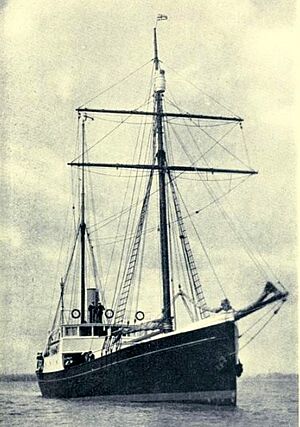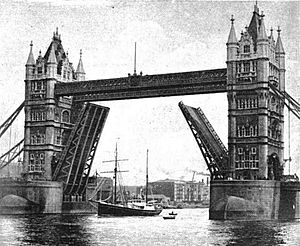Quest (ship) facts for kids
The Quest was a special ship that sailed the seas from 1917 until it sank in 1962. It was a schooner-rigged steamship, meaning it used both sails and a steam engine to move. The Quest is most famous for being the ship used by Sir Ernest Shackleton on his last polar adventure, the Shackleton–Rowett Expedition in 1921–1922. Sadly, Sir Ernest Shackleton died on board the Quest on January 5, 1922, while the ship was in South Georgia.
Before and after Shackleton's expedition, the Quest worked as a commercial seal-hunting vessel, also known as a "sealer." It was also the main ship for the British Arctic Air Route Expedition to Greenland in 1930–1931. The Quest was about 33.8 meters (111 feet) long and 7.3 meters (24 feet) wide.

Quest
|
|
Quick facts for kids History |
|
|---|---|
| Name |
|
| Owner |
|
| Operator |
|
| Port of registry | |
| Builder | Erik Lindstøls Båtbyggeri, Risør |
| Launched | 1917 |
| Identification | |
| Fate | Foundered 5 May 1962 in the Labrador Sea |
| General characteristics | |
| Type |
|
| Tonnage |
|
| Length | 110 ft 7 in (33.71 m) |
| Beam | 24 ft 9 in (7.54 m) |
| Depth of hold | 11 ft 8 in (3.56 m) |
| Propulsion |
|
| Sail plan | Schooner |
Contents
Shackleton's Last Journey: The Shackleton-Rowett Expedition

The Quest was first built in Risør, Norway, in 1917. It was a wooden ship designed for seal hunting and was originally called Foca I or Foca II. In 1921, it was chosen to be the exploration ship for the Shackleton-Rowett Expedition. Lady Emily Shackleton, the wife of the famous explorer Ernest Shackleton, gave the ship its new name, Quest.
The expedition's sponsor, John Quiller Rowett, paid for the Quest to be specially prepared. Frank Worsley, the ship's sailing master, oversaw the changes. They added new sails and a small house-like structure on the deck called a deckhouse. Because Shackleton was a member of the Royal Yacht Squadron, the Quest was allowed to use "RYS" after its name and fly a special flag called the White Ensign.
The Quest left London on September 17, 1921, heading for the Southern Ocean. It arrived at South Georgia on January 4, 1922. The very next night, Shackleton, the leader of the expedition, passed away on the ship while it was anchored in Grytviken. This sad event meant the expedition could not explore the Antarctic coastline as planned.
After Shackleton's death, Frank Wild took over. The Quest sailed around the Weddell Sea area for a while before returning to the South Atlantic. In May, the ship stopped at the Tristan da Cunha islands. There, a bird expert named Hubert Wilkins found some special birds called grosbeak buntings.
The expedition returned to England in July 1922. The journey had been difficult, and the ship's steam engine often caused problems. Also, the Quest's front part, called the stem, was straight, which made it hard for the ship to move through icy waters.
Adventures in East Greenland
In 1924, the Quest was refitted in Norway. During this work, the deckhouse that was added for Shackleton's expedition was removed and used on land. In 1928, the ship helped rescue people who survived the crash of the Airship Italia in the Arctic.
In 1930, the Quest, which was getting older, became the main ship for the British Arctic Air Route Expedition. This expedition, led by Gino Watkins, traveled from London to eastern Greenland. The ship was described as a "broad-beamed, tubby little ship, decks stacked with gear." From 1932 to 1936, the Quest was also used by Count Gaston Micard for his expeditions to East Greenland.
Return to Service, Sinking, and Discovery
After 1930, the Quest went back to being a seal-hunting vessel. In 1935, it was used by the British East Greenland Expedition. During World War II, the wooden ship was used by the military as a minesweeper (a ship that clears sea mines) and to carry light cargo.
In 1946, the small ship returned to hunting seals. On May 5, 1962, while on a seal-hunting trip, the Quest was damaged by crushing ice and sank off the north coast of Labrador. Luckily, all the crew members were saved.
Some parts of the Quest still exist today. Pieces of the old deckhouse, including Shackleton's cabin from 1921–1922, are now in the Athy Heritage Center – Museum in Ireland. The crow's nest (a lookout barrel high on the mast) is in a church in London called All Hallows-by-the-Tower.
A collection of 476 old photographs from the Quest/Shackleton-Rowett Expedition is kept at the State Library of New South Wales in Sydney, Australia.
On June 9, 2024, the Quest was found at the bottom of the Labrador Sea! It was less than half a kilometer from Labrador's north coast. A team led by the Royal Canadian Geographical Society, including famous shipwreck hunter David Mearns, found the ship. It was sitting almost upright in 390 meters (about 1,280 feet) of water and looked mostly whole, except for a broken main mast.
See also
 In Spanish: Quest (barco) para niños
In Spanish: Quest (barco) para niños

